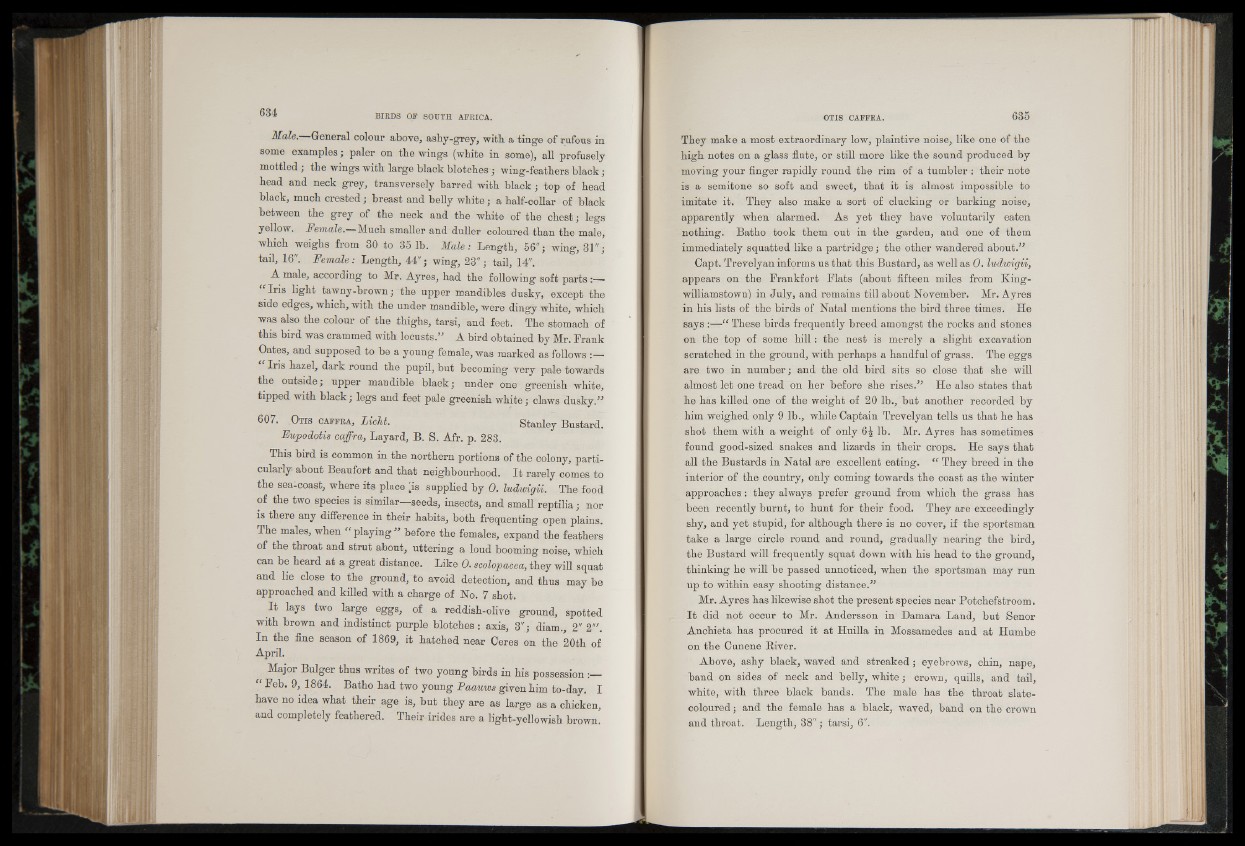
Male. General colour above, ashy-grey, with a tinge of rufous in
some examples; paler on the wings (white in some), all profusely
mottled ; the wings with large black blotches ; wing-feathers black;
head and neck grey, transversely barred with black; top of head
black, much crested; breast and belly white; a half-collar of black
between the grey of the neck and the white of the chest» legs
yellow. Female. Much smaller and duller coloured than the male,
which weighs from 30 to 35 1b. Male: Length, 56"; wing, 31";
tail, 16". Female: Length, 44"; wing, 23"; tail, 14".
A male, according to Mr. Ayres, had the following soft parts
Iris light tawny-brown; the upper mandibles dusky, except the
side edges, which, with the under mandible, were dingy white, which
was also the colour of the thighs, tarsi, and feet. The stomach of
this bird was crammed with locusts.” A bird obtained by Mr. Prank
Oates, and supposed to be a young female, was marked as follows :—
Iris hazel, dark round the pupil, but becoming very pale towards
the outside; upper mandible black; under one- greenish white,
tipped with black; legs and feet pale greenish white; claws dusky.”
607. O t is carrra, Licht. Stanley Bustard.
Eupodotis caffra, Layard, B. S. Afr. p. 283.
This bird is common in the northern portions of the colony, particularly
about Beaufort and that neighbourhood. I t rarely comes to
the sea-coast, where its place ;is supplied by 0. ludwigii. The food
of the two species is similar—seeds, insects, and small reptilia; nor
is there any difference in their habits, both frequenting open plains.
The males, when "playing” before the females, expand the feathers
of the throat and strut about, uttering a loud booming noise, which
can be heard at a great distance. Like 0. scolopacea, they will squat
and lie close to the ground, to avoid detection, and thus may be
approached and killed with a charge of No. 7 shot.
It lays two large eggs, of a reddish-olive ground, spotted
with brown and indistinct purple blotches: axis, 3"; diam., 2" 2"/.
In the fine season of 1869, it hatched near Ceres on the 20th of
April.
Major Bulger thus writes of two young birds in his possession:_
Feb. 9, 1864. Batho had two young Paauws given him to-day. I
have no idea what their age is, but they are as large as a chicken,
and completely feathered. Their irides are a light-yellowish brown.
They make a most extraordinary low, plaintive noise, like one of the
high notes on a glass flute, or still more like the sound produced by
moving your finger rapidly round the rim of a tumbler : their note
is a semitone so soft and sweet, that it is almost impossible to
imitate it. They also make a sort of clucking or barking noise,
apparently when alarmed. As yet they have voluntarily eaten
nothing. Batho took them out in the garden, and one of them
immediately squatted like a partridge; the other wandered about/'’
Capt. Trevelyan informs us that this Bustard, as well as 0. ludwigii,
appears on the Frankfort Flats (about fifteen miles from King-
williamstown) in July, and remains till about November. Mr. Ayres
in his lists of the birds of Natal mentions the bird three times. He
says :—“ These birds frequently breed amongst the rocks and stones
on the top of some hill: the nest is merely a slight excavation
scratched in the ground, with perhaps a handful of grass. The eggs
are two in number; and the old bird sits so close that she will
almost let one tread on her before she rises.” He also states that
he has killed one of the weight of 20 lb., but another recorded by
him weighed only 9 lb., while Captain Trevelyan tells us that he has
shot them with a weight of only 6 | lb. Mr. Ayres has sometimes
found good-sized snakes and lizards in their crops. He says that
all the Bustards in Natal are excellent eating. “ They breed in the
interior of the country, only coming towards the coast as the winter
approaches: they always prefer ground from which the grass has
been recently burnt, to hunt for their food. They are exceedingly
shy, and yet stupid, for although there is no cover, if the sportsman
take a large circle round and round, gradually nearing the bird,
the Bustard will frequently squat down with his head to the ground,
thinking he will be passed unnoticed, when the sportsman may run
up to within easy shooting distance.”
Mr. Ayres has likewise shot the present species near Potchefstroom.
It did not occur to Mr. Andersson in Damara Land, but Senor
Anchieta has procured it at Huilla in Mossamedes and at Humbe
on the Cunene River.
Above, ashy black, waved and streaked; eyebrows, chin, nape,
band on sides of neck and belly, white; crown, quills, and tail,
white, with three black bands. The male has the throat slate-
coloured ; and the female has a black, waved, band on the crown
and throat. Lensrth, 38" : tarsi. 6".